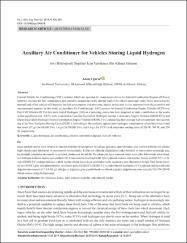Auxiliary Air Conditioner for Vehicles Storing Liquid Hydrogen
Abstract
Current Vehicle Air Conditioning (VAC) systems, which are operated by compressors driven by Internal Combustion Engines (ICEs) orbatteries, increase the fuel consumption and emissions depending on the thermal load of the vehicle passenger cabin. Since decreasing thethermal load of the vehicle will decrease the fuel consumption and emissions, studies in this area is very important from the economic andenvironmental aspects. In this study, an Auxiliary Air Conditioning (AAC) system for Internal Combustion Engine Vehicles (ICEVs) orFuel Cell Vehicles (FCVs) that store Liquid Hydrogen (LH2) as a powering source has been proposed to make contribution to the worksin this significant area. ICEVs were evaluated as Gasoline Equivalent Hydrogen Internal Combustion Engine Vehicles (GEHICEVs) andDiesel Equivalent Hydrogen Internal Combustion Engine Vehicles (DEHICEVs) considering their average fuel consumption rates accordingto the New European Driving Cycle (NEDC). According to the analyses, approximate hydrogen consumption values have been foundthat reach 0.7 g/s for GEHICEVs, 1.6 g/s for DEHICEVs, and 0.6 g/s for FCVs with maximum cooling rates of 326 W, 704 W, and 250W, respectively. İçten yanmalı motor veya batarya ile hareket ettirilen bir kompresör ile çalışan günümüz taşıt klimaları, taşıt yolcu kabininin ısıl yüküne bağlı olarak yakıt tüketimini ve emisyonları artırmaktadır. Kabin ısıl yükünün düşürülmesi yakıt tüketimi ve emisyonları azaltacağı için, bu alandaki çalışmalar ekonomik ve çevresel yönden çok önemlidir. Bu çalışmada, içten yanmalı motor veya yakıt hücresinde yakıt olarak sıvı hidrojen kullanan taşıtlar için yardımcı bir klima sistemi önerilmektedir. İçten yanmalı motoru olan taşıtlar, benzin (GEHICEV) ve dizele (DEHICEV) eşdeğer hidrojen yakıtlı taşıtlar olmak üzere ikiye ayrılmakta ve bu taşıtların yakıt tüketimleri Avrupa Yeni Sürüş Çevrimi’ne (NEDC) göre hesaplanmaktadır. Analizlere göre; GEHICEV, DEHICEV ve yakıt hücreli taşıtlarda (FCV) yaklaşık hidrojen tüketim değerlerinin sırasıyla 0.7-1.6-0.6 g/s olduğu ve değerlere göre yapılabilecek en yüksek soğutma değerlerinin yine sırasıyla 326-704-250 W olarak ortaya çıktığı bulunmuştur.
Source
International journal of advances in engineering and pure sciences (Online)Volume
31Issue
4URI
https://doi.org/10.7240/jeps.590618https://app.trdizin.gov.tr/makale/TXpNeE9EQXdNQT09
https://hdl.handle.net/20.500.11857/2531



















